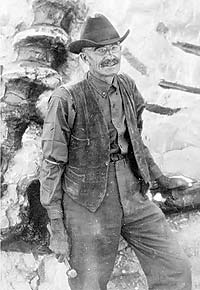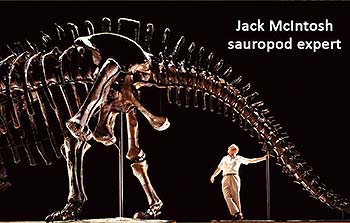 |
| Earl Douglass (1862-1931) the paleontologist who found the bone bed that would become Dinosaur National Monument had a striking resemblance to Groucho Marx. |
What do a small cottage in Scotland, the town of Allegheny, Pennsylvania and Dinosaur National Monument have in common? The answer is a man named Andrew Carnegie who rose from humble Scottish roots in the 1830s to became, by 1890, one of the world’s most famous and wealthy industrialist-philanthropists. Most “famously,” despite building a massive steel empire Carnegie had a life-long interest in education and made huge financial contributions to found libraries, museums and even universities. He once wrote “No idol is more debasing that the worship of money” and vowed to give away his fortunes.
While the noble institutions founded by Carnegie back east were flourishing, the wild west towns of today’s Dinosaur Diamond were barely incorporated, proverbial “wide spots in dirt roads” with minuscule populations: Vernal 664; Price 539; Fruita 126; Moab 376. Nevertheless, before 1910, big institutions back east were already sending paleontologists out west to dig up dinosaurs. Last month (Happenings Jan 2022) we mentioned Elmer Riggs’s excavation of Brachiosaurus near Grand Junction in 1900. Here we focus on paleontologist Earl Douglass who worked for the Carnegie Museum (Pittsburgh) and who will be forever remembered for his 1909 discovery of the dinosaur bone bed that would become the Carnegie Quarry and focal point of Dinosaur National Monument, created in 1915, near Vernal.
As in the case of the Grand Valley discoveries around Fruita, the Carnegie material all came from the Jurassic Morrison Formation, famous as a graveyard for a some of the world’s largest dinosaurs: notably the sauropods, including a practically complete Apatosaurus skeleton, and skeletons named Brontosaurus installed in Yale Peabody Museum. The Carnegie specimen was named Apatosaurus louisae in honor of Carnegie’s wife Louise. Famously this nearly complete skeleton did not have its skull attached, even though one was found nearby, and so was at first mounted “headless” in the Carnegie Museum. Later in the 1930s the skull of a related sauropod, Camarasaurus, was installed.
 |
Jack McIntosh 1923-2015 was a physicist whose true passion and in-depth knowledge was sauropods.
Photo by Louis Psihoyos. |
Fast forward to the 1970s when Jack McIntosh, a Yale-trained theoretical physicist, whose true passion was sauropods, redescribed the skull of Apatosaurus, and thanks to him, in 1979, the first true skull of Apatosaurus was mounted on the Carnegie skeleton. By then, other skeletons had been given the wrong heads. When the head on the Yale skeleton was replaced, some said “beheaded and re-headed” T shirts were on sale saying “I lost my head at the Yale Peabody Museum.”
It is not unusual to debate the reconstruction of dinosaurs long after they were first discovered, and in fact the “beheading and re-heading” story is intimately connected with the discovery that Apatosaurus and Brontosaurus represent the same animals, with Apatosaurus having priority as the first named (A before B as it happens). So, the story of the Carnegie Quarry Apatosaurus involved many players, and as paleontologist Kenneth Carpenter, who we shall meet again soon, has reported, there was more to the story of Douglass’s discovery than finding and excavating bones and creating a national monument. Rather, there was what Carpenter calls a “rocky start” involving debates and disputes over the interests of Carnegie, the state of Utah, and the federal government regarding ownership of the quarry and sending Utah’s fossils back east. More importantly the National Monument Act was designed to protect fossils and other antiquities in place. Thus, a good sample of bones remain in place to this day, and are seen by ~300,000 visitors annually. But the simple story is that Earl Douglass is the man originally associated with the monument. It was he who found and excavated the historic specimens. Beside his dinosaurs, with hammer and chisel in hand, and bearing an uncanny resemblance to a rugged Groucho Marx, he embodied the iconic image of a pioneer, wild west paleontologist from the early 1900s.
 |
| Apatosaurus louisae was named after Louise Carnegie wife of philanthropist Andrew Carnegie |
|